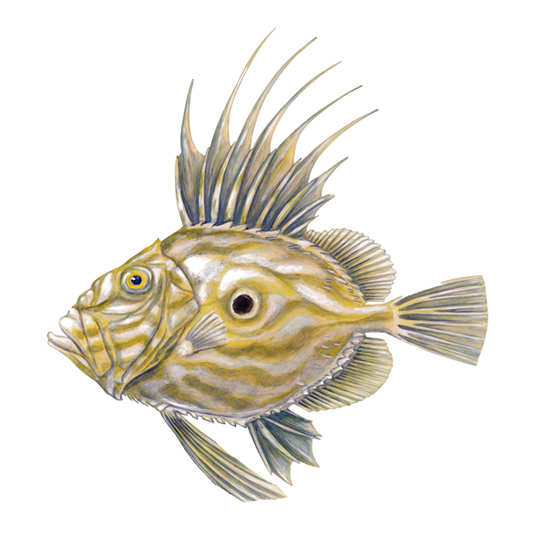

A strange looking, but delicious fish a, john dory's bizarre shape and long fins make it look from another planet. It has a large mouth which is used to suck in very large prey items such as fish and shrimps. It has a black spot on each side of the body which is said to be the thumb print of St Peter. It has a fantastic scientific name being named after Zeus, king of the Greek gods.
John dory is caught as a valuable by-catch in trawl and net fisheries. Little is known about stocks of john dory but there is no evidence that numbers are decreasing, however they are a species which has a relatively high vulnerability to fishing. fishing for john dory is not managed well, there are no minimum landing sizes or limit on catch (quota). Due to their strange shape young john dory are easily caught in fishing gear and they can't easily escape thorugh mesh or escape gaps. Avoid eating small john dory smaller than 29cm that haven't had the opportunity to spawn yet.
In 2021 a total of 78 tonnes of John dory were landed to Cornish ports with a value of £719k (MMO data).
Updated July 2023
Cornish vessels landing to Cornish ports
Gill nets are lightweight nets made of nylon (monofilament) fishing line that are anchored to the seabed and are used to catch fish by entangling the gills.
Learn moreCornish vessels landing to Cornish ports
Demersal trawls are large nets that are pulled through the water with the bottom edge of the net touching the seabed. At each edge the net is pulled open by metal ‘trawl doors’. Sometimes referred to as Otter trawling.
Learn moreCornish vessels landing to Cornish ports
Beam trawls are nets attached to a steel beam that holds the net open. The belly of the net is made of chains and the upper surface of the net is mesh. Beam trawlers pull two nets along the seabed simultaneously.
Learn moreCornwall Good Seafood Guide rates fish on sustainability using a scale of 1 to 5.
1, 2 and 3 are recommended, Fish to avoid are rated 5.
We use the system devised by the Marine Conservation Society (MCS) so our scores are comparable with the scores produced by MCS for the UK and fisheries from all around the world. For more information on scoring click here.
John dory are caught in Cornish waters by gill nets and in demersal and beam trawls.






Cornwall Good Seafood Guide is underpinned by the Marine Conservation Society (MCS) Good Fish Guide. The first UK consumer guide to sustainable seafood. For more information visit www.fishonline.org
Cornwall Good Seafood Guide is here to help us all make sustainable seafood choices. Choices that will help us keep the oceans healthy and Cornish fishers' futures safe. This website is funded by Cornwall Wildlife Trust. If you would like to make a meaningful difference to the health of our oceans, please consider making a donation to the Cornwall Wildlife Trust Ocean Emergency fund. Your donation will help safeguard these remarkable environments, ensuring that they continue to thrive for generations to come. Together, we can be stewards of the seas and champions for a healthier, more sustainable future.